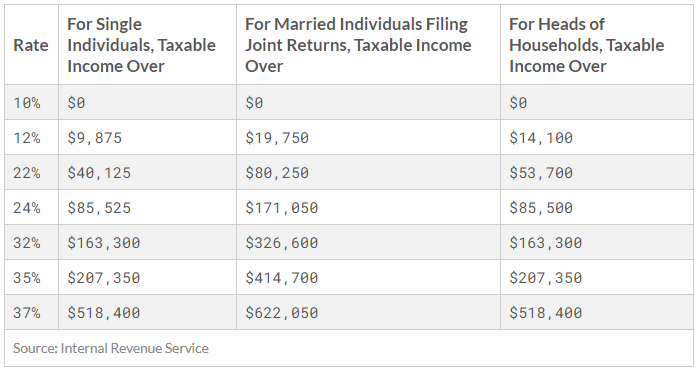These tax-efficient investing strategies will boost your returns.
Why Tax-Efficient Investing Strategies Matter
Let’s be honest, avoiding taxes on your investments isn’t the first goal of your portfolio. Your first goal is to maximize earnings. However, no good investment strategy is complete without an awareness of your potential tax burden.
In a nutshell: taxes reduce your net gains.
You may jump for joy each time an investment win materializes. But with each gain comes the need to pay taxes. Over time, higher taxes have a significant effect on your long-term investment returns.
Shaving off a percentage or two from your tax burden may give you more money to invest, generate growth, and get you closer to achieving your financial goals.
So working with a financial planner who favors tax-efficient strategies and coordinates with your tax professional is the best way to keep more of the assets you’re growing. Here’s how:

5 Smart Tax-Efficient Investment Strategies
Follow these five tips, and you’ll limit your tax liability and keep more of your gains:
1. Be Smart About Asset Location
There are two types of investment accounts: taxable and tax-deferred, i.e. individual retirement accounts, 401(k)s, 403(b)s, etc.
A smart asset-location strategy involves holding investments in the type of account that provides the most beneficial tax treatment, giving you all the benefits of each type of account while lowering your tax bill.
Taxable Accounts: Better For Investments Focused on Growth, Not Income
The money that you put into a taxable account is often the savings you’ve accumulated after you’ve contributed the maximum amount to your employer’s retirement plan or your IRA. It could also be money that you may need to access throughout your life so you need the flexibility that’s not available in a retirement account.
Since every dollar earned in a taxable account is taxed once the investment is sold, you want to be as smart as possible about minimizing those taxes.
Investments that generate relatively lower taxes should be held in taxable accounts, such as:
- Individual stocks (held for at least one year)
- Tax-efficient stock funds, index funds, exchange-traded funds (ETFs), and low-turnover stock funds
- Growth stocks and mutual funds that pay little or no dividends
- Municipal bonds
If you hold your investments for at least one year, the earnings are taxed at the long-term capital gains rate of 0%, 15%, or 20% (depending on your adjusted gross income).
If you hold your investments for less than one year, the earnings will be subject to the ordinary income tax rate, which can be as high as 37%.
Tax-Advantaged Accounts: Best For Investments That Generate Income
Tax-advantaged accounts can be either tax-deferred or tax-exempt.

Tax-deferred accounts provide a tax benefit upfront. Since they’re funded with pre-tax contributions, they reduce your current taxable income. Examples of tax-deferred accounts include a Traditional IRA and 401(k).
You are, essentially, deferring the taxes until retirement that you would otherwise pay now on the contributions and, throughout your life, on investment earnings. At that point, you will pay ordinary income taxes on every dollar you withdraw from the account. Since you will no longer be in your high earning years, you will most likely be in a lower income tax bracket.
Tax-exempt accounts provide tax-free growth. Examples of tax-exempt accounts include Roth IRAs and Roth 401(k)s.
While you can’t deduct your contributions as you can for tax-deferred accounts (since you contribute after-tax dollars), whatever gains you earn are exempt from taxes. Furthermore, withdrawals you make in retirement will be tax-free.
Assets that generate income should be placed in tax-advantaged accounts, such as:
- Individual stocks paying high dividends
- Actively managed mutual funds earning substantial short-term capital gains
- Taxable bonds including corporate bonds, inflation-protected bonds, zero-coupon bonds, and high-yield bonds
- Real estate investment trusts (REITs)
Ideally, you’ll want to diversify your portfolio long-term with investments in both taxable and tax-advantaged accounts.
2. Tax-Loss Harvest Throughout the Year
Tax-loss harvesting helps lower your capital gains and thus the taxes you pay on them in a given year and possibly future years.
If the value of an investment falls below the price you paid for it, you can sell it at a loss and replace it with a similar investment that gives you the same exposure you had with the original investment. A simplified example would be to sell one technology stock at a loss and, at the same time, buy another technology stock to replace it (hopefully, with better projected performance). The loss would be a deduction on your tax return, and you would still be invested in a technology stock. If you have other investment gains, the loss would offset them and thus lower your tax liability.
When calculating your taxes, your realized capital losses (losses generated from the sale of investments) are first used to offset any realized capital gains (gains from the sale of investments). If you lost more than you gained, you can deduct up to $3,000 in realized losses over and above gains to offset ordinary income taxes.
If your losses still exceed the $3,000 limit, they may be “carried forward” and apply to your realized investment gains in future tax years indefinitely.
You can only apply tax-loss harvesting to taxable accounts. Remember, tax-deferred accounts grow tax-free, so they’re clear of capital gains taxes.
Continually rebalancing your portfolio is crucial for spotting investments prime for tax-loss harvesting. This is especially important if you have capital gains taxed in the highest income bracket.
3. Manage Your Income Tax Brackets
One of the best tax strategies for high income earners is to manage your marginal income tax brackets each year. This means that, as much as possible, you should time your income and/or deductions strategically to keep you within the lowest bracket.

How do you reduce your taxable income?
Max out your contributions to tax-deferred retirement accounts, like a Traditional IRA or 401(k). Since they’re made with pre-tax contributions, they’ll lower your taxable income and defer taxes until you withdraw them in retirement (when you may be in a lower tax bracket).
Take necessary withdrawals from your after-tax accounts first, such as savings accounts or individual brokerage accounts. You may be taxed on net realized gains, taxable interest income, and dividends, but you won’t be taxed on the withdrawals. Or you can withdraw from a Roth IRA (assuming you meet age requirements and the Roth is at least five years old) and not be taxed at all.
Manage the timing of your employer-granted stock options. You may be able to defer this income to a future year when your total income may be lower. Exercising in-the-money options allows your assets to continue growing without any capital outlay.
Anticipate potential gains and distributions from mutual funds. Mutual funds must distribute all their net gains to shareholders at least once a year. This keeps them from paying corporate income taxes on their profits.
Most dividend distributions are considered regular income and get taxed at your ordinary income tax rate (unless they’re qualified dividends). But capital gains distributions may be taxed at the 20% capital gains tax rate (for those in the highest income bracket).
It may be wise to sell these investments before the capital gains are distributed if the potential distributions would bump you into a higher tax bracket.
Conversely, in a year where your income is lower than usual, you should consider converting all or part of a traditional IRA to a Roth IRA. You would pay ordinary income tax on the amount converted, but in a low-income year, you would not be pushed into a higher tax bracket. From then on, all earnings would be tax free.
4. Disburse Trust Assets Strategically
Are you the beneficiary of a trust that distributes income to you?
Trust marginal tax rates are similar to individual tax rates, but the taxable income levels are much lower. Joint filers would need to earn $622,051 per year in 2020 to fall into the highest income tax bracket of 37%, but the taxable income in a trust only needs to reach $12,950 to get taxed at this level.
The investments held in a trust earn taxable income throughout the year. Those taxes can be paid by the trust and remain in the trust or distributed to the beneficiary and taxed at his or her marginal rate.
If the beneficiary is in a low income tax bracket like a student, unemployed person or a retiree might be, it may make more sense to have the income taxed at his or her rate rather than a higher trust tax rate.
The income should be assigned to the taxpayer--trust or beneficiary--where it will be taxed at the lowest rate. This reduces the overall taxes paid.
5. Utilize Tax-Efficient Exchange-Traded Funds (ETFs)

ETFs are one of the best tax-efficient investment strategies.
Whereas actively managed funds buy and sell investments more often, resulting in the potential to generate more capital gains distributions (and taxes for you), most ETFs are passively managed.
Investors only pay taxes on capital gains when the entire ETF is sold. So you’ll never pay taxes on ETF shares while you hold them.
Tax-Efficient Investing: Keep More of What You Earn with Castle Wealth Management
Tax-efficiency isn’t the only consideration to think about when making investment decisions for your future. But being aware of it will certainly help you minimize your tax liability so you don’t lose a major portion of what you’ve worked so hard to gain.
Then whatever you save employing these tax strategies can be used to reinvest in your financial goals, whether that’s saving for retirement, a new house, or a trust for those you love.
Want to make smarter decisions with your money? We’ll help you keep more of what you earn and grow it for the future. Connect with Castle Wealth Management today!

